Using the 6-Note Songbook - Thekalimba
Here's a remarkable fact: if you have a large kalimba with many notes, it's quite possible that you can use the teaching material from a kalimba with fewer notes, but you need to know which teeth are assigned to the kalimba's smaller notes.
I was talking to a customer who really wanted the 8-note kalimba and not the 6-note kalimba, but she really liked the songs in the 6-note book, which contains several spiritual ones. I told her I could play all the songs in the 6-note book on her 8-note kalimba, and we showed her how. But first, why would anyone want to do that?
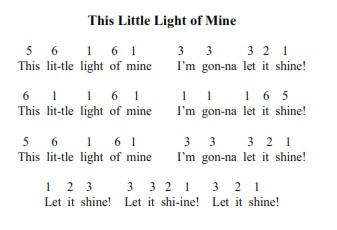
The songs in the 6-note pentatonic book are written in digital tablature. They are simple, familiar melodies. Because they are written with numbers that represent degrees of scale instead of geometric tablature, these songs can be played in any kalimba where you have these degrees of scale.
Write the note numbers on the appropriate teeth with a Sharpie marker. You can remove them with alcohol wipes.
If you don't know what I mean by numbers representing "scale degrees", I mean "1, 2, 3" = "Do Re Mi" or "Doe a Deer". What is called a "C chord" in the 6-note book is in fact any chord that has 1 as its lowest note and 8 as its highest note. By the way, 8 is the same note as 1, but an octave higher.
The second part of the Book of 6 notes uses a "5 chord", which has the fifth on the bass. Songs like "Amazing Grace" and "This Little Light of Mine", "As I We Down to the River to Pray" and "Swing Low, Sweet Chariot" have an octave range, but start and end on the fifth. I think this chord is more useful than the original chord, which starts and ends on note 1 or root.
In the 6-note Kalimba, you have to fine-tune a note from "C Tuning" to "5 Tuning" in F, but in Kalimbas with more notes, you don't have to retune, but you do have to know which numbers to write in which teeth.
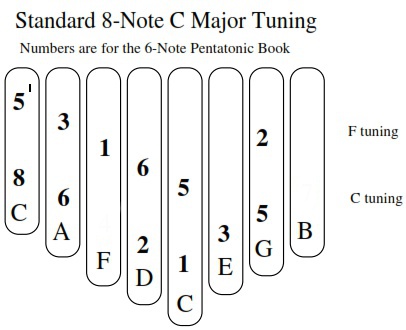
The table above shows the standard 8-note Kalimba tuning notes in C. Notes 1, 2, 3, 5, 6, 8 are above the note names: note that notes 4 and 7 are missing. These six notes are the "C chord" notes covered by the first part of the 6-note book. Further down the diagram, you'll see notes 5, 6, 1, 2, 3, 5 and # 39; these represent the "F setting", which is a "chord based on 5", which you need to play the second part of the book (the notation 5 indicates the value 5, which corresponds to an octave above the value 5).
By the way, when you play in "tuning 5", you're in the key of F, which wants to have a Bb instead of a B. Natural. This note, 4, is not required on the pentatonic scale and, as it's B's bad taste for the F scale, try to avoid playing it by accident.
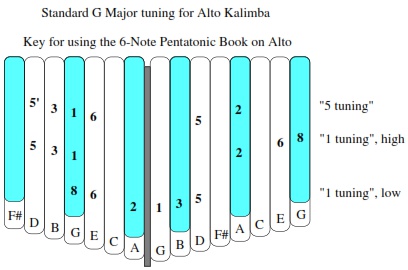
The 15-note High Kalimba has so many teeth that you won't have to bend the keys (C and F) as we did with the 8-note kalimba. You can play both "1 chord" and "5 chords" on the G key. However, at least to start with, I suggest you name only the minimum 6 notes of your kalimba.
Another luxury of having 15 notes: you can choose between a lower "tuning 1" or a higher "tuning 1" (which reads the "tuning C" part of the 6-note notebook; we don't call it "tuning C" here because This Kalimba is in G.) That is, once you've mastered the songs in the first part of the six-note book in the lower octave of your upper Kalimba, you can brush your teeth, write down the numbers in the upper octave and learn the same thing. It's another important step in familiarizing yourself with your High Kalimba.
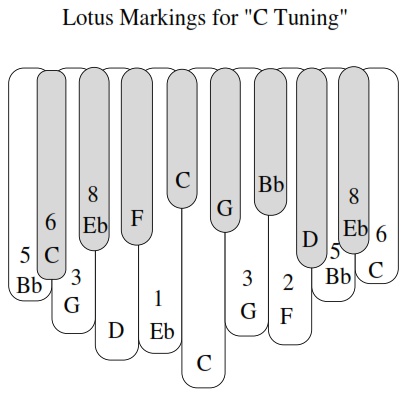
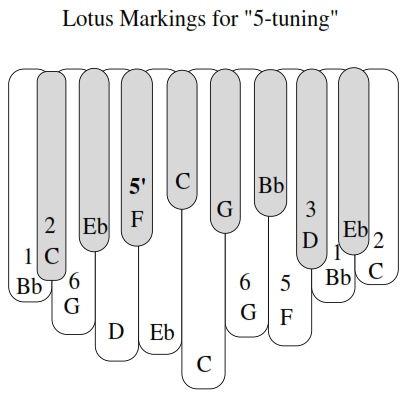
The Lotus Karimba is a strange instrument: it's easy to play music with an excellent sound, but it's difficult to get it to play a specific song because the notes are presented in such a strange pattern. If you're interested in progressing with this instrument and actually learning to play specific songs, it's a good idea to start by marking the teeth with numbers as in the previous diagrams and get the 6-note pentatonic book.
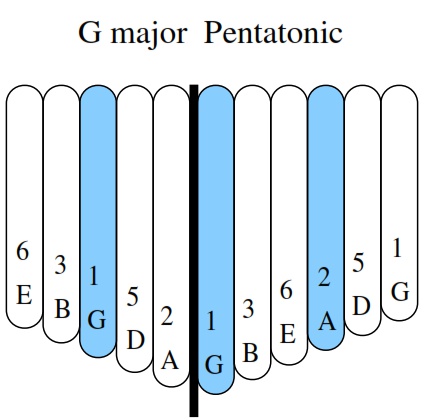
Here's another example of how to use the 6-note book with a different kalimba: the 11-note pentatonic kalimba. The degrees of the scale are shown here. Like the Alto Kalimba, you can choose to learn the lower octave or the upper octave for "1-tuning" songs. You can see where the "5-tuning" notes go: start at D = 5 on the left-hand side and work your way up (6, 1, 2, 3), ending at D = 5 on the right-hand side of the instrument.
If the Kalimba you're looking for isn't there, you can search for it in the tuning library, where most tunings are presented with scale degrees. Standard and alternative tunings for more than a dozen Kalimbas (totalling over one hundred separate agreements).
. (tagsToTranslate) kalimbas (t) thumb pianos (t) finger pianos (t) kalimba music (t) kalimba teaching material (t) kalimba how to play kalimba songs (t) kalimba videos (t) videos ) karimba (t) mbira (t) Hugh Tracey kalimba instruments
[ad_2]